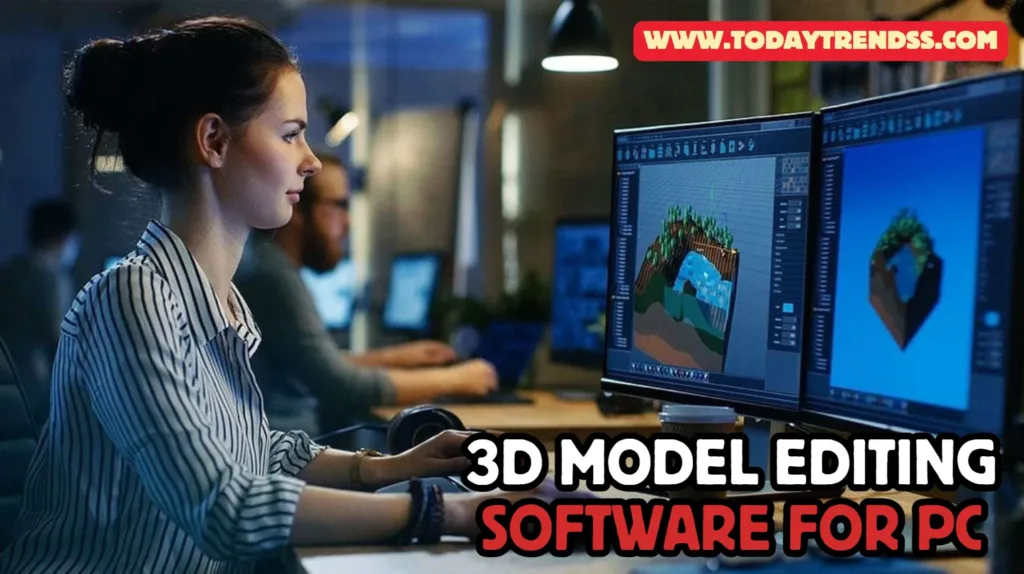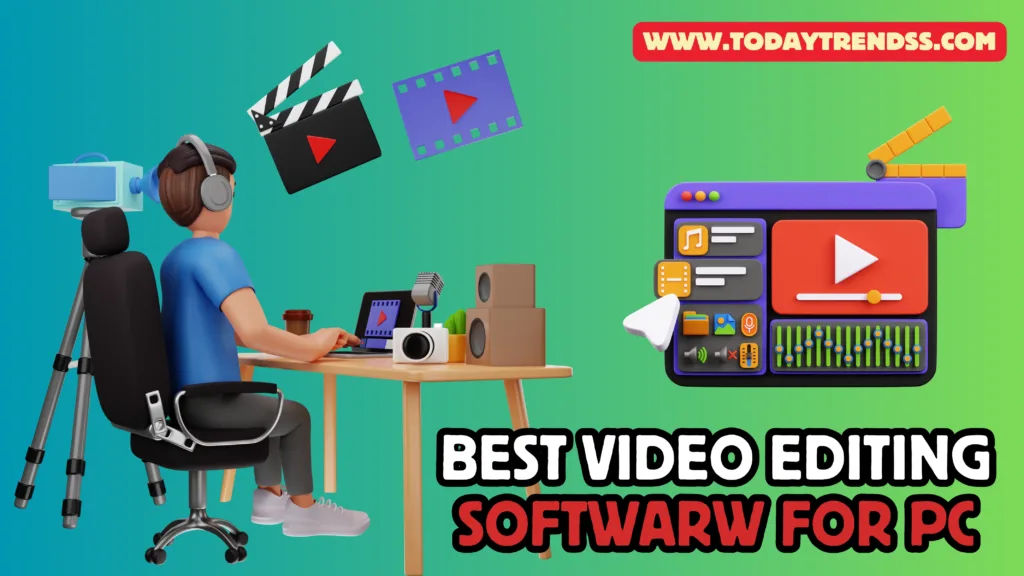5 Best 3d Model Editing Software for PC
As of 2024, the top 5 3D model editing software for PCs include a mix of versatile, powerful, and specialized tools suitable for various needs, from animation to industrial design. Here are the top picks.

1. Autodesk Maya
Autodesk Maya: The Premier 3D Modeling Software for PC
In the vast arena of 3D modeling and animation software, Autodesk Maya stands out as a powerhouse, revered by professionals in the fields of animation, video games, and visual effects. Known for its robust features and versatility, Maya is widely regarded as the best 3D modeling software for PCs. Here’s a deep dive into what makes Autodesk Maya a top choice for creators around the globe.
Unmatched Feature Set
Maya’s comprehensive toolset is one of its most significant advantages. It offers a wide array of features that cater to both the artistic and technical needs of professionals. Key features include:
- Advanced Simulation Tools: Maya excels in creating realistic animations with its sophisticated dynamics and effects. This includes the Bifrost for procedural effects, a graph editor that allows artists to create versatile and scalable simulations.
- Powerful Rigging and Animation Tools: Character rigging in Maya is both flexible and robust, allowing for intricate and realistic movements. The animation toolkit supports a multitude of techniques, from keyframe animation to motion capture integration.
- Integrated Rendering Solutions: Maya comes with Arnold renderer integration, which facilitates the creation of stunning visuals with a high level of realism. Arnold is known for its ability to handle complex characters, scenery, and lighting challenges effortlessly.
- Extensive Modeling Tools: Whether it’s NURBS, polygons, or subdivision surfaces, Maya provides comprehensive modeling tools that are versatile and user-friendly, enabling the creation of both organic and hard-surface models.
Industry Standard
Maya is not just a tool; it’s an industry-standard in many sectors. Its use is widespread among the top animation studios and visual effects companies worldwide. Films that have utilized Maya include blockbusters like “Avatar”, “Frozen”, and “The Avengers”. The software’s ability to integrate into various pipelines and its compatibility with other production tools make it invaluable for large-scale projects.
Community and Support
Autodesk provides extensive support and learning resources, which is a boon for both beginners and seasoned professionals. The community around Maya is vast, with numerous forums, tutorial websites, and YouTube channels dedicated to mastering its intricacies. Autodesk’s help documentation and continuous updates also play a crucial role in supporting its user base.
Customization and Extensibility
One of Maya’s key strengths is its extensibility. Users can customize the software using its built-in scripting languages, MEL (Maya Embedded Language) and Python. This allows for the automation of repetitive tasks, the development of custom tools, and significant enhancements to the workflow, making Maya highly adaptable to any project’s needs.
Comparison with Competitors
While there are other formidable software options like Blender (which is free) and Cinema 4D, Maya often comes out on top for professional use due to its superior toolset and industry acceptance. Although it comes with a steep price tag, its depth and breadth of features justify the investment for many professionals.
Conclusion
Autodesk Maya remains the top choice for professionals seeking comprehensive, powerful, and versatile 3D modeling software for PCs. Its combination of advanced features, industry-standard status, and robust community support ensures that it remains at the forefront of the digital content creation industry. For those looking to dive into 3D modeling, animation, or visual effects at a professional level, Maya offers a compelling, though pricey, pathway to mastering these crafts.
2. Blender
Blender: The Premier 3D Modeling Software for PC
In the dynamic world of 3D modeling and animation, one software stands out for its versatility, power, and zero price tag: Blender. Developed by the Blender Foundation, Blender is an open-source 3D creation suite that supports the entirety of the 3D pipeline—modeling, rigging, animation, simulation, rendering, compositing, and motion tracking, even video editing and game creation. This article explores why Blender is considered the best 3D modeling software for PCs, detailing its features, community support, and how it compares to other industry-standard tools.
Comprehensive Feature Set
Blender offers a comprehensive range of features that make it a competitive choice for professionals and hobbyists alike. Its capabilities include:
- Modeling and Sculpting: Blender provides extensive modeling tools. Users can perform tasks from creating basic shapes to complex sculpting using its multi-resolution and dynamic subdivision features.
- Animation & Rigging: Known for its robust animation tools, Blender allows for intricate rigging of models and sophisticated animation controls. This makes it suitable for both simple animations and complex cinematic effects.
- Simulation: Whether you need realistic particle systems, cloth physics, or soft body dynamics, Blender has simulation capabilities that can add lifelike effects to your projects.
- Rendering: Blender comes with its built-in renderer, Cycles, which is a path-tracer engine enabling stunning ultra-realistic rendering. More recently, it has added support for Eevee, a real-time renderer, for quick, quality previews.
- Video Editing: Unlike many other 3D tools, Blender includes a full video editor that allows video cuts and splicing, as well as more complex tasks like video masking.
- Game Creation: The Blender Game Engine enables users to create and prototype games directly within the software, although it has been phased out in favor of interactive content that can be made with its general animation tools.
Community and Support
- One of Blender’s biggest advantages is its community. Being open-source, it has attracted a vast network of users and developers who continuously contribute to its development, ensuring the tool is up-to-date and progressive. Blender’s community forums, user groups, and dedicated websites are treasure troves of tutorials, plugins, and advice, which are invaluable for both beginners and professionals.
- Moreover, Blender’s open-source nature means users have access to its source code and can customize the tool according to their needs. This unique feature encourages innovations and improvements that are shared back with the community.
Cost-Effective Solution
Blender is completely free to download and use for any purpose, including commercial projects. This accessibility makes it an ideal option for students, small studios, and startups that may find the high costs of other 3D software prohibitive. In comparison, other high-end 3D software packages can come with hefty price tags or subscription fees.
Industry Acceptance
Blender’s acceptance in the professional market is growing. It is being adopted by more studios for its cost-efficiency and robust feature set. Films like “Next Gen” on Netflix and game studios using Blender for asset creation reflect its rising credibility and capability to meet industry demands.
Challenges and Considerations
While Blender is powerful, newcomers might find its interface challenging. However, recent updates have focused on improving the user experience, making it more intuitive. Additionally, while Blender is very powerful, it can require a significant amount of learning to harness its full potential, similar to any other high-end software in this field.
Conclusion
Blender is not just another free tool; it is a comprehensive suite that rivals other expensive software in 3D modeling, animation, and rendering. For anyone looking to delve into the world of 3D creation, from beginners to professionals, Blender offers a feature-rich, community-supported platform without the financial burden. Its continuously improving features and growing acceptance in professional environments herald its status as the premier 3D modeling software for PCs. Whether for animation, simulation, or game development, Blender stands out as a top choice in the 3D software arena.
3. Adobe Substance 3D
Adobe Substance 3D: The Leading 3D Model Editing Software for PCs
In the realm of digital design and 3D modeling, Adobe Substance 3D has emerged as a front-runner, offering an expansive suite of tools that cater to professionals in game development, animation, and visual effects. Here, we delve into why Adobe Substance 3D is considered the best 3D model editing software for PC users, examining its comprehensive features, intuitive user interface, and powerful performance capabilities.
Overview of Adobe Substance 3D
Adobe Substance 3D is a collection of software tools designed for the creation and editing of 3D textures and materials in a fully procedural and non-destructive workflow. The suite primarily includes Substance Painter, Substance Designer, and Substance Stager, among other tools, which integrate seamlessly with each other and other Adobe products, like Photoshop and Illustrator, enhancing productivity and creativity.
Key Features and Capabilities
- Substance Painter: This tool allows users to paint textures on 3D models in real-time. With a vast library of materials and custom brushes, artists can create detailed and realistic surfaces with ease. Its particle painting technology lets users add intricate details like cracks, dirt, and rust naturally as they paint, simulating real-world wear and tear.
- Substance Designer: Known for its flexibility, Substance Designer is the core of creating procedural textures. It is used for developing tileable textures from scratch or tweaking existing ones, and it supports a node-based editing system. This enables designers to build complex materials using a non-destructive workflow.
- Substance Stager: This tool helps in setting up and rendering 3D model scenes. It combines intuitive layout tools with powerful lighting and camera options, allowing artists to compose and visualize scenes in realistic detail.
Integration and Ecosystem
One of Adobe Substance 3D’s strengths is its deep integration with the broader Adobe Creative Cloud suite. This allows for a fluid workflow for designers who rely on multiple Adobe applications. For instance, textures created in Substance can be imported into Adobe Dimension or used as materials in Adobe Aero for AR projects.
Performance and Efficiency
Substance 3D is optimized for performance across a broad range of PC configurations, which means it can run efficiently on both high-end and mid-range systems. The software’s ability to handle complex and heavy textures without significant slowdowns is a testament to its robust engineering.
Community and Learning Resources
Adobe offers a substantial array of tutorials, forums, and documentation for Substance 3D users. The community around Substance 3D is vibrant and collaborative, with numerous experienced users and beginners alike sharing tips, tutorials, and custom materials. Adobe’s regular updates and feature additions also ensure that the software remains at the cutting edge of technology and user needs.
Conclusion
For professionals seeking a powerful, intuitive, and integrative toolset for 3D models on PCs, Adobe Substance 3D stands out as the best choice. With its comprehensive suite of tools designed to enhance creativity and efficiency, it is aptly equipped to handle the demands of modern 3D modeling projects. Whether you’re working in game design, film, or digital media, Adobe Substance 3D offers the capabilities and support necessary to bring creative visions to life with high fidelity and detail.
4. Autodesk 3DS Max
Autodesk 3DS Max: The Premier 3D Modeling Software for PCs
In the world of 3D modeling and animation, Autodesk 3DS Max stands out as one of the best software solutions available for PC users. Known for its extensive feature set, powerful capabilities, and user-friendly interface, 3DS Max is widely employed by professionals in the fields of game development, film, and architectural visualization. This article explores the key features, benefits, and applications of Autodesk 3DS Max, shedding light on why it is highly regarded among 3D model artists and designers.
Comprehensive Toolset
Autodesk 3DS Max offers a robust suite of tools designed to meet the needs of advanced users while remaining accessible to newcomers. The software provides a comprehensive range of functionalities including modeling, texturing, and animation, alongside advanced effects like particle simulation, character rigging, and support for dynamic simulations with its built-in physics engine, MassFX. These tools are instrumental in creating intricate digital scenes and highly detailed 3D models.
User-Friendly Interface
Despite its complex capabilities, 3DS Max boasts an intuitive user interface that makes it easier for beginners to navigate and learn the software. With a customizable workspace and a context-sensitive ribbon interface, users can streamline their workflow to improve efficiency and productivity. The interface supports drag-and-drop features, and extensive help documentation is available, making it straightforward for users to understand and apply advanced techniques.
Wide Industry Adoption
3DS Max’s versatility and power are underscored by its widespread use across multiple industries. In the entertainment sector, it is used for creating video game assets, CGI for films, and pre-visualizations. Architectural firms utilize it for 3D architectural renderings and virtual tours. Furthermore, its integration capabilities with other Autodesk products, like AutoCAD and Revit, facilitate a seamless workflow across different stages of project development.
Strong Community and Support
One of the critical factors behind the success of Autodesk 3DS Max is its vibrant community and extensive ecosystem. Users benefit from a vast array of third-party plugins, ready-to-use assets, and comprehensive learning materials available through forums, tutorials, and online courses. Autodesk also provides regular updates and professional support, ensuring that users have access to the latest industry standards and technology advancements.
Real-World Applications
The practical applications of 3DS Max are diverse:
- Game Development: It is extensively used in creating detailed 3D characters, environments, and in-game assets.
- Film and Visual Effects: Studios rely on it for generating complex effects, character animations, and detailed visual backgrounds.
- Architectural Visualization: Architects and designers create photorealistic renders of buildings and interiors, enhancing client presentations and project plans.
Conclusion
Autodesk 3DS Max remains a top choice for professionals looking for comprehensive 3D modeling and animation software on the PC platform. With its powerful features, intuitive interface, and broad industry adoption, it facilitates creative exploration and professional production across various sectors. Whether for creating blockbuster films, immersive games, or visionary architectural designs, 3DS Max offers the tools and flexibility needed to bring creative ideas to life.
5. Houdini by SideFX
Houdini by SideFX: A Leader in 3D Model Editing for PC
In the ever-evolving world of digital animation and visual effects, few tools have made as significant an impact as Houdini by SideFX. Renowned for its powerful procedural generation capabilities, Houdini has become a cornerstone in the workflows of animators, visual effects artists, and game developers. This article delves into why Houdini is considered one of the best 3D model editing software for PCs, exploring its features, usability, and applications in various industries.
Unmatched Procedural Workflow
At the heart of Houdini’s prowess is its procedural workflow capability, which sets it apart from other 3D modeling software. Unlike traditional 3D software where changes are often destructive and linear, Houdini operates on a node-based system. Each action or operation performed in Houdini creates a node. These nodes can be adjusted, rearranged, or reused without affecting the initial model, allowing for a highly flexible and non-linear workflow. This system not only saves significant time for a project but also enhances creativity, as artists can experiment without the risk of permanently altering their original models.
Robust Feature Set
Houdini excels in several key areas that are critical for 3D modeling and animation:
- Dynamics and Simulation: Houdini is arguably the industry leader when it comes to dynamics and simulation. Whether it’s smoke, fire, fluid, cloth, or complex particle effects, Houdini offers state-of-the-art tools that allow for creating incredibly realistic simulations.
- Volumetrics: The software’s volumetric capabilities are essential for creating complex effects like clouds, fog, or explosive effects. Houdini’s volumetric engine handles these tasks with ease, providing artists the tools to create detailed and realistic environments.
- Modeling and Geometry: Houdini includes a broad range of tools that facilitate the creation of both organic and inorganic models. Its procedural approach allows for intricate detailing and control, which can be particularly beneficial in environments and character modeling.
- Lighting and Rendering: Integrated with Mantra, its powerful rendering engine, Houdini allows for the creation of highly realistic renders. Mantra is renowned for its ability to handle complex calculations and produce photorealistic images, crucial for final production in films and games.
Industry Applications
Houdini’s capabilities make it a preferred tool across various sectors:
- Film and Television: Houdini has been used in numerous blockbuster films and TV shows to create spectacular visual effects. Its ability to handle complex simulations and effects seamlessly integrates with the production pipelines of major studios.
- Video Games: Game developers utilize Houdini’s procedural features to generate vast landscapes and intricate game environments. Its adaptability allows for optimizations that are crucial in real-time game rendering.
- Virtual Reality (VR) and Augmented Reality (AR): As VR and AR continue to grow, Houdini’s ability to create immersive and interactive 3D environments makes it an invaluable tool for developers in these fields.
Learning Curve and Community
While Houdini offers unmatched capabilities, it is also known for its steep learning curve. However, SideFX has invested in extensive documentation and a series of tutorials that help new users get started. Moreover, the Houdini community is vibrant and supportive, with numerous forums, workshops, and third-party tutorials available to assist users at all levels.
Conclusion
Houdini by SideFX stands out as one of the best 3D model editing software available for PC due to its robust feature set, flexibility, and wide industry adoption. Its procedural node-based workflow system allows unparalleled control and efficiency, making it a favorite among professionals aiming to push the boundaries of digital animation and visual effects. Whether for film, television, video games, or immersive experiences, Houdini offers the tools and capabilities to bring creative visions to life. With continuous updates and a supportive community, Houdini not only meets the current demands of the industry but is also poised to evolve with future technological advancements.


